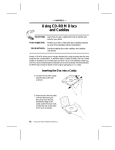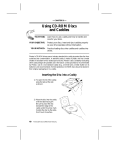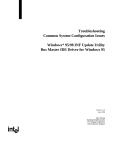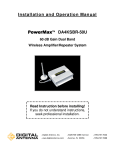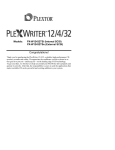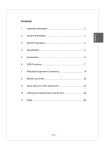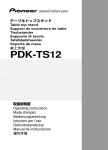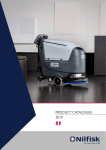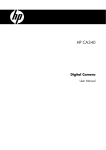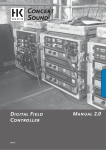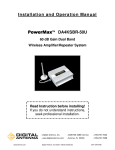Download Epson ActionPC 2000 User Setup Information
Transcript
EPSON ® READ THIS FIRST About Your EPSON Computer Printed on recycled paper with 10% post-consumer content @ IMPORTANT NOTlCE DISCLAIMER OF WARRANTY Epson America makes no representations or warranties, either express or implied, by or with respect to anything in this manual, and shall not be liable for any implied warranties ofmerchantability and fitness for a particular purpose or for any indirect, special, or consequential damages. Some states do not allow the exclusion of incidental or consequential damages, so this exclusion may not apply to you. COPYRlGHT NOTlCE All rights reserved. No part of this publication may be reproduced, stored in a retrieval system, or transmitted, in any form or by any means, electronic, mechanical, photocopying, recording, or otherwise, without the prior written permission of Epson America, Inc. No patent liability is assumed with respect to the use of information contained herein. Nor is any liability assumed for damages resulting from the use of the information contained herein. Further, this publication and features described herein are subject to change without notice. TRADEMARKS EPSON is a registered trademark of Seiko Epson Corporation ActionPC and ActionTower are trademarks and EPSON Connection is a service mark of Epson America, Inc. General Notice: Other product names used herein are for identification purposes only and may be trademarks of their respective companies. Copyright 0 1994 by Epson America, Inc. Torrance, California, USA ii Read This First 400367200 8/94 Contents Introduction . . . . . . . . . . . . . . . . . . . . . . . Installed Equipment and Software . . . . . . . . . . Introducing FocalPoint . . . . . . . . . . . . . . Where to Get Help . . . . . . . . . . . . . . . . . . . . CompuServe On-line Support . . . . . . . . . . Multimedia Systems . . . . . . . . . . . . . . . . . . . Sound Card and CD-ROM Drive Compatibility Installed Software . . . . . . . . . . . . . . . . . Connecting the Speakers . . . . . . . . . . . . . Adjusting the Sound . . . . . . . . . . . . . . . . Testing Your Multimedia System . . . . . . . . Running Berenstain Bears from DOS . . . . . . Troubleshooting Your Multimedia System . . . . . . Diagnosing Sound Card Problems . . . . . . . Diagnosing CD-ROM Drive Problems . . . . . 1 1 5 6 8 8 9 10 11 14 14 16 17 18 25 Read This First iii lntroduction Before you set up and use your EPSON® system, be sure to read the information in this booklet about the equipment and software installed on your computer. The following section describes the equipment and software included with all systems. If you have a multimedia system, be sure to read “Multimedia Systems, “beginning on page 8, for information about your additional equipment and software. If you do not have a multimedia system but you later install your own multimedia equipment, be sure to read “Multimedia Systems” for any information that may then apply to your computer. lnstalled Equipment and Software In addition to the components described in your computer User's Guide, your system comes with the following equipment and software, depending on which computer you purchased: 0 ActionPCTM2000 or ActionTower TM2000 include a built-in fax/modem, a cable for connecting it to your phone line, and a user manual describing both the fax and modem functions. Follow the instructions in the modem manual to connect the fax/modem to your phone line. WinFax® LITE fax software is installed on your computer’s hard disk drive and is available by selecting an icon in the Microsoft® Windows™ PFS:® Applications program group or from an icon in EPSON’s FocalPoint™Utility group. (FocalPoint is described on page 5.) To operate your modem, you can use the Windows Terminal program or the software provided with CompuServe® and America Online.® (These programs are described below.) Read This First 1 0 ActionPC 3000 or ActionTower 3000 come with a built-in voice/ fax/ data modem. Among its features are a voice mail system and the ability to send and receive faxes. A cable for connecting the modem to your phone line and a user manual describing all of the modem’s functions are included. Follow the instructions in the user manual to connect the modem to your phone line. Pacific Image® Communications’ SuperVoice™ software integrating voice, fax, and data communications is installed on your computer’s hard disk drive. See the SuperVoice user manual for instructions on using the program. For additional help with SuperVoice, contact the manufacturer at these numbers: (818) 457-9684 Technical support: (818) 457-8881 Fax: (818) 457-8880 Sales: (818) 457-9189 BBS: Internet: [email protected] All of these computers comes with a wide variety of other software loaded on the hard disk drive. To learn about these programs, read the user manual or brochure that comes with each one. If you need to contact the software manufacturer for additional information, the phone numbers are included in the list below. (Not all 800 numbers may be available in Canada.) 0 2 Microsoft MS-DOS® 6.2 operating system software, installed on the hard disk drive, including a user manual and diskettes EPSON ConnectionSM Technical support: at (800) 922-8911 (U.S. only) or (800) 463-7766 (Canada only) Read This First 0 Microsoft Windows 3.11 graphical user interface software, installed on the hard disk drive, including a user manual and diskettes EPSON Connection Technical support: at (800) 922-8911 (U.S. only) or (800) 463-7766 (Canada only) 0 Spinnaker® PFS: WindowWorks business management software installed on the hard disk drive along with a user manual (800) 227-5609 Customer service: (404) 428-0008 Technical support: (404) 427-1150 Fax: Interactive voice/ faxback: (404) 514-6330 0 IntuitTM Quicken® for Windows financial planning software installed on the hard disk drive along with a user manual (800) 624-8742 (U.S. and Canada) Customer service: (415) 858-6095 (outside U.S. or Canada) (415) 858-6059 Technical support: (415) 858-6090 Faxback: 0 Intuit Quickbooks® bookkeeping software demonstration program installed on the hard disk drive, including a brochure and ordering information (800) 624-8742 (U.S. and Canada) Customer service: (415) 858-6095 (outside U.S. or Canada) (415) 858-6059 Technical support: (415) 858-6090 Faxback: Read This First 3 4 0 Sierra® On-Line Hoyle® Classic Card Games software installed on the hard disk drive along with a user manual (206) 644-4343 Technical support: (800) 743-7725 (U.S. and Canada) Customer service: (800) 757-7707 (U.S. and Canada) Sales: (900) 370-5583 Hint line: Interactive voice/ faxback: (800) 376-2683 (U.S. and Canada) (209) 683-3633 Fax: (209) 683-4463 BBS: 0 InterplayTMRussian 6-PakTMgame software installed on the hard disk drive along with a user manual (714) 553-6678 Technical support: (714) 252-2820 Fax: (714) 252-2822 BBS: 0 America Online news and installed on the hard disk subscription information Technical support: BBS: information service software drive, including a brochure and (800) 827-6364 (800) 827-5808 0 CompuServe WinCIM® information manager for the CompuServe news and information service installed on the hard disk drive, including a brochure and subscription information (800) 848-8990 Customer service: 0 Sierra On-Line Dynamix® The Even More MachineTMpuzzle software installed on the including a user manual and diskettes (206) 644-4343 Technical support: (800) 743-7725 Customer service: (800) 757-7707 Sales: (900) 370-5583 Hint line: Interactive voice/ faxback: (800) 376-2683 (209) 683-4463 BBS: Read This First Incredible hard disk drive, (U.S. and Canada) (U.S. and Canada) (U.S. and Canada) Introducing FocalPoint Your system includes EPSON’s FocalPoint, a Windows environment program. FocalPoint was designed to provide easy access to the Windows programs, utilities, and games on your computer, as well as on-line information about EPSON products and services. When you turn on or reset your computer, it automatically starts FocalPoint after loading MS-DOS and Windows. The FocalPoint screen includes these four sections: 0 Three large program group selection buttons on the left 0 The program icon selection screen in the middle, including “previous page” and “next page” buttons with a page number in the upper right corner 0 Four small system control buttons on the right 0 A description box on the bottom of the screen with information on the currently highlighted item. To learn more about FocalPoint and for help moving between the FocalPoint screens, select the Help button with the blue ? icon on the right side of the screen. Always properly exit any program you are using and then computer to ensure that your data is saved correctly. ti Read This First 5 If desired, you can prevent your computer from starting FocalPoint automatically but still make it available from its Windows icon. To do so, select the Exit button with the door icon on the right side of the screen. Then open the Windows Startup group, if necessary. Move the FocalPoint icon from that group to another convenient Windows group. (See your Windows documentation for instructions on using Windows.) Where to Get Help If you have trouble using any of the software mentioned in this booklet, first check to see if the software includes on-line help and/or a user manual and look there for information. Many programs also provide support through CompuServe; check your software documentation for information about obtaining help this way. If these sources do not help you solve the problem, contact the software manufacturer for assistance at any of the numbers given in this booklet. Note It is a good idea to periodically back up your entire hard disk drive, or at least your program directories, so you can restore your program files without using program diskettes. We recommend that you back up the program directories of any software for which you do not have the original program diskettes. If you need to reinstall any software and you do not have a backup, you may need to obtain program diskettes from the manufacturer. Contact them at the number(s) listed in this booklet. (Usually you can order diskettes by calling the “Customer service” number.) 6 Read This First If you need additional help, EPSON provides customer support and service through a network of Authorized EPSON Customer Care Centers. EPSON also provides support services through the EPSON Connection. In the United States, dial (800) 922-8911. In Canada, dial (800) GO-EPSON. Call the EPSON Connection for the following: 0 Technical assistance with the installation, configuration, and operation of EPSON products 0 Assistance in locating your nearest Authorized EPSON Reseller or Customer Care Center 0 Customer Relations 0 EPSON technical information library fax service 0 Product literature on current and new products. You can purchase accessories, manuals, or parts for EPSON products from EPSON Accessories at (800) 873-7766 (U.S. sales only). In Canada, call (800) GO-EPSON for sales locations. When you call for technical assistance, be ready to identify your system and its configuration, and provide any error messages to the support staff. See your computer User's Guide for more information. For on-line information about EPSON products, services, and contact numbers, select the EPSON information icons from the Software program group in FocalPoint. Read This First 7 CompuServe On-line Support The fastest way to access helpful tips, specifications, drivers, application notes, tables for DIP switch or jumper settings, and bulletins for EPSON products is through the Epson America Forum on CompuServe. If you are already a CompuServe member, simply type GO EPSON at the menu prompt to reach the Epson America Forum. If you are not currently a member of CompuServe, select the Membership Signup icon in FocalPoint or in the Windows CompuServe program group, and check the CompuServe brochure for information on subscribing to the service. Multimedia Systems If you purchased a multimedia system, your computer also comes with a double-speed CD-ROM drive, a 16-bit sound card, and two speakers. The CD-ROM drive and the sound card are already installed. You need only connect the speakers to the computer. Caution If you have a multimedia tower system, do not place the computer on its side because the CD-ROM drive cannot operate in a vertical position. This section describes your sound card and multimedia software, and tells you how to connect the speakers and test your system. It also includes instructions for running any MS-DOS-based game software you may have. 8 Read This First Caution If you purchased additional equipment or software for your computer (such as disk drives or a word processing program), do not install them until you test your system as it was configured at the factory. This will ensure that your system is operating properly before you install any optional items. See “Testing Your Multimedia System” on page 14. If you have trouble using your multimedia equipment, check the suggestions in “Troubleshooting Your Multimedia System” on page 17. Sound Card and CD-ROM Drive Compatibility Your 16-bit stereo sound card can be used with Sound Blaster,TM Sound Blaster Pro,™ AdLib,™ MPC, and MT-32 compatible games and applications. It also includes an interface for a Sony,® Mitsumi,® Panasonic,® or IDE CD-ROM drive. Your sound card can also be upgraded with an optional daughter card to provide wavetable synthesis. You can also use Windows Sound System compatible applications with your sound card; follow the instructions in your sound card manual to install the Windows Sound System drivers. Your CD-ROM drive is a double-speed, MPC2 compliant drive that supports multi-session photo CD and is CD-ROM XA ready. Caution If you experiment with the connections on your sound card or CD-ROM drive, do not connect the CD-ROM drive or the IDE interface on the sound card to the IDE interface on your computer’s main system board. Read This First 9 lnstalled Software In addition to the software listed on pages 2 through 6, your multimedia system includes this additional software: A system Sound ImpressionTMsoftware for playing, editing, and recording Wave files, and for playing MIDI files and CDs, installed on your hard disk drive along with a user manual Technical support: EPSON Connection at (800) 922-8911 (U.S. only) or (800) 463-7766 (Canada only) Compton’s® Interactive EncyclopediaTM installed on your hard disk drive along with a CD and a user manual (619) 929-2626 Technical support: (619) 929-2690 Fax: (800) 862-2206 Sales: Compton’s Berenstain Bears Learning at Home, Volume 1 DOS-based children’s software installed on your hard disk drive along with a CD; see the instructions on page 16 to run this software (619) 929-2626 Technical support: (619) 929-2690 Fax: (800) 862-2206 Sales: Compton’s KGB/ CIA World FactbookTM statistical database software installed on your hard disk drive along with a CD and a user manual (619) 929-2626 Technical support: (619) 929-2690 Fax: (800) 862-2206 Sales: Paramount Interactive MovieSelect TM movie guide software installed on your hard disk drive along with a CD (415) 813-8030 Technical support: (415) 813-8045 Fax: 10 Read This First Note To use any of the CD programs, you must place its CD in the CD-ROM drive and wait at least 10 seconds before you access the program. If you own any music CDs, see the CD-ROM drive manual that came with your computer for instructions on playing them on your system. You can also use the Sound Impression program on your computer to play music on CD while you are using your computer. See your sound card manual and the Sound Impression on-line help information for instructions. Connecting the Speakers The speakers that come with your multimedia system can be used as unamplified or amplified speakers. If you connect the speakers to your computer without installing batteries they are unamplified. If you install batteries or power the speakers using a DC 6-Volt input jack, they are amplified speakers. You connect the speakers to either the SPK or OUT port on your computer’s sound card, depending on whether you are using amplified or unamplified speakers. Follow the guidelines in the table below to determine the port you should use: Speakertype Port EPSON speakerswithout batteries (unamplified) SPK EPSON speakerswith batteries or connected to DC 6-Volt input jack (amplified) Other manufacturer’s speakers (unamplified) SPK Other manufacturer’s speakers (amplified) Read This First 11 Note You can install C-type batteries in your speakers or obtain a DC 6-Volt input jack to power the speakers independently and use them as amplified speakers. This will boost the speaker’s bass response and allow you to adjust the volume using the speaker’s controls. If you do this, be sure to set the Amp switch on the back of each speaker to the On position and turn on the speakers before you turn on your system. Be sure to connect the speakers to the OUT connector on the sound card, as described below. Before you connect your speakers, locate the battery compartment on the back of each one. Inside the compartments are the cables you use to connect the speakers to the computer. Remove the cables. If necessary, attach one of the cable’s wide connectors to the socket on the back of each speaker. If you are using your speakers as unamplified speakers, you must do the following before you connect them to your system: 0 Turn off your computer 0 If there is a power button on the front of each speaker, set it to the Off position 0 If there is an Amp switch on the back of each speaker, set it to the Off position to turn off the speaker’s amplifier. Caution Do not connect mono speakers to the OUT connector; you could damage the speakers’ amplifiers. 12 Read This First Both speakers are connected to one speaker cable. Connect this cable to the appropriate port on your computer’s sound card, as shown below. OUT IN MIC game or joystick port If you want to connect headphones to your sound card, connect them to the OUT connector. (Headphones mute the sound from your speakers.) You can connect the line-out connector of a radio, CD player, stereo, or other device to the IN connector. To connect a microphone, use the MC connector. (The microphone must have 600 Ohm impedance or less.) Use the MIDI game port on the sound card to connect a game cable or joystick with a 15-pin, D-sub connector. Caution Do not press either speaker’s power button or change the setting of the Amp switch while they are connected to the computer. Also do not plug or unplug the speaker cable from the sound card when the speakers are operating or play the speakers at an excessively high volume. Read This First 13 Adjusting the Sound To adjust the speaker’s volume and other operating characteristics, select the Sound Impression or Mozart Mixer program icons in Windows. Follow the instructions in the on-line help program to select the sound you prefer. If you are not using Windows when you need to adjust the speaker volume, you can use the following keyboard commands: 0 Ctrl Alt U (to increase the volume) 0 Ctrl Alt D (to decrease it) 0 Ctrl Alt M (to mute it). Testing Your Multimedia System To test your system as it was configured at the factory, connect only your monitor, keyboard, and mouse as described in your computer User's Guide. Also connect your speakers, as described in the previous sections. Then follow the instructions in your computer User's Guide for turning on your system. After your computer performs its power-on diagnostic loads your operating system (MS-DOS) and Windows. the Windows registration screen and select the printer have connected. (See your Windows manual or on-line instructions.) tests, it Fill out you help for After a few moments, the computer starts FocalPoint. Follow these steps to test your system : 1. 14 Follow the instructions in your CD-ROM drive manual to load one of the CDs that came with your system in the CD-ROM drive. Read This First 2. In FocalPoint, move the cursor to the Software button (on the top left side of the screen) or the Games button (on the bottom left side) to locate the program for which you loaded the CD. Click the left mouse button once. 3. Move the cursor to the program icon for which you loaded the CD and click the left mouse button once. 4. Follow the instructions in the program documentation to test some of the operations of the program. Be sure the program’s video and audio functions operate correctly. 5. Exit the program and return to FocalPoint. 6. Select the Exit button (the door icon on the right side of the FocalPoint screen) to exit to Windows Program Manager. 7. Select the Exit Windows command from the File menu to exit Windows. 8. Remove the CD from the CD-ROM drive and turn off your system. When you finish testing your system and are sure it is working correctly, see your computer User's Guide for instructions on installing your optional equipment. Also read the instructions there for running the Setup program and performing general system operations, such as resetting your system and using a password. If you have any trouble with your system, check the troubleshooting information beginning on page 17. Read This First 15 Running Berenstain Rears from DOS The program Compton’s Berenstain Bears Learning at Home, Volume 1 is an MS-DOS-based program that cannot be run from a Windows icon like your other multimedia programs. To run Berenstain Bears, you must exit Windows (if you are currently using it) and enter a command at the MS-DOS prompt. Note If you purchased any additional MS-DOS-based game programs, you must also run them from the MS-DOS prompt as described here. See the program documentation for information about the directory in which the program is stored and the command you should use to start it. First insert the Berenstain Bears CD in your CD-ROM drive. Then follow these steps to start the program from the MS-DOS prompt: 1. If you are in Windows, you can access the MS-DOS prompt by selecting Exit from the Windows File menu and exiting Windows. If you are in FocalPoint, first select the Exit button (a door icon) to exit to Windows Program Manager. 2. When you see the C: \ prompt, type the following and press Enter to log onto the Berenstain Bears program directory: CD \ATHOME 3. Now type the following and press Enter to start the program START 4. 16 After a few moments, you see the program’s title screen. Read This First Troubleshooting Your Multimedia System If you have any trouble using your multimedia system, check the following sources for solutions to the problem : For problems with optional equipment or software you may have installed, consult any on-line or printed help information that came with the product or contact the software manufacturer. If you have trouble using any of the software that came with your system from the factory, consult any on-line or printed help information that came with the software or contact the manufacturer at the number(s) listed in this booklet. If you suspect the problem involves your multimedia equipment (your sound card and/ or CD-ROM drive), check the manuals that came with your computer for troubleshooting procedures. If your computer seems to be causing the problem, see your computer User's Guide for troubleshooting information. You can also try the multimedia system troubleshooting steps outlined in this section to help you solve the problem. Caution The troubleshooting procedures in this section are intended for experienced computer users only. If you have any reservations about using these instructions, see “Where to Get Help” on page 6 for information on available support services. Read This First 17 Diagnosing Sound Card Problems If you suspect you have trouble with your sound card, check the following: 0 If you are using a game or other multimedia software program and the audio is distorted or non-existent, first check that your speaker cable is firmly connected to the appropriate connector on your sound card. Also try adjusting Windows, use the program to adjust use the Ctrl Alt U decrease volume) the speakers’ volume. If you are in Mozart Mixer or Sound Impressions it. If you are using MS-DOS applications, (to increase volume) and Ctrl Alt D (to commands. You can also try testing the sound card by connecting audio headphones to the OUT port on the sound card to see if sound is produced through that port. Sound distortion may also be caused by interference from another option card in your computer. Make sure that no card’s components or cables are touching the sound card. You may want to move the sound card to a different slot. See your computer’s User's Guide for instructions on removing and installing an option card. To run a sound card diagnostic program, exit Windows and log onto the C:\ MOZART directory. Type MZTTEST and press Enter to start the program. Follow the instructions on the screen to test various aspects of your sound card. If your game or other software program can be run under MS-DOS or under Windows, try running the program under MS-DOS (if you experience problems running under Windows). Check your software documentation to see if this is possible. 18 Read This First 0 If you still have problems, you may have a conflict between the DMA, IRQ, and other settings of your sound card and any optional card drivers you may have installed. Conflicts in these areas can also cause your computer to lock up, spontaneously reboot, or issue a parity error. If you experience any of these problems, follow these steps: 1. Use the MS-DOS Edit utility or the Windows SysEdit utility to check the contents of your computer’s AUTOEXEC.BAT and CONFIG.SYS files. See your MS-DOS manual (or the on-line Help utility) for instructions on using Edit. To use SysEdit, select the SysEdit icon from the FocalPoint Utility program group or from the Windows Application group. Also check the contents of these Windows initialization files for potential conflicts: WIN.INI and SYSTEM.INI. See your Windows on-line Help utility for instructions on identifying the commands in these files. 2. In your CONFIG.SYS file, make a note of the DMA, IRQ, base I/O address, ROM I/O address, and ROM IRQ settings of the driver MZTINIT.SYS. The default settings for the switches controlling these items is as follows: DMA: IRQ : Base I/ 0: CD-ROM I/ 0: CD-ROM IRQ: / / / / / D:1 I:5 A220 CA170 CI15 Read This First 19 Also check the following switches in the SET command line in your AUTOEXEC.BAT file: Base I/ 0: DMA: IRQ : BLASTER / Annn / Dn / In Some Sound Blaster games require settings that match those of your sound card. Check your game documentation to see how to change the game’s settings to match those of your sound card. 3. Make a note of the DMA and IRQ settings in the Windows SYSTEM.INI file for the Mozart driver. The default settings are as follows: DMA=0 IRQ=11 Use the Windows Control Panel to view the current settings. Select Drivers; then select Mozart Audio Device Driver from the list displayed and click on Setup. You see the DMA and IRQ (Interrupt) settings. 20 4. Now check the DMA, IRQ, base I/O address, CD-ROM I/O address, and CD-ROM IRQ settings of the driver(s) in your CONFIG.SYS file for the optional card you have installed. See the card documentation for information about identifying the driver and its switches. 5. If there is a conflict between these settings, test the sound card to see if it works properly when the optional card driver is not installed. To do this, edit the CONFIG.SYS file and insert the letters REM (for remark) followed by a space at the beginning of the line containing the driver installation command. This temporarily disables the command. Reboot your system. Read This First If the sound card operates properly, change the settings used by your optional card’s driver in the CONFIG.SYS file so they do not conflict with the settings of the MZTINIT.SYS driver. Do not change the settings of the MZTINIT.SYS driver itself. Reboot the system. 0 Some programs also add PATH statements and executable commands to start the program in your AUTOEXEC.BAT file. This may cause the program to displace the conventional memory needed by other programs and cause various applications to be inoperable. To temporarily remove statements or commands added to your AUTOEXEC.BAT file by programs you suspect are causing a problem, insert the letters REM (for remark) followed by a space at the beginning of the line containing the suspect statement or command. The line then looks like this: REM C: \path\filename. Save the new version of the AUTOEXEC.BAT file, reboot your computer, and see if the rest of your programs operate correctly. You can also try loading the suspect programs into high memory using the MS-DOS MemMaker utility. See your MS-DOS manual (or on-line help) for instructions. 0 Some games do not work if your computer is running at high speed. If this is the case with your game, follow the instructions in your computer User's Guide to lower the processor speed and try running the game again. 0 Did you experience a problem following the sequence of events described below? a. You used one of your memory-intensive CD programs b. Then attempted to use another CD program c. But your system did not recognize the other program Read This First 21 d. So you rebooted your system using Ctrl Alt Del e. And the system did not load your sound card or CD-ROM drivers. If so, reset the computer by turning it off, waiting 20 seconds, and turning it back on again. This should resynchronize the sound card. If your computer still has trouble recognizing a program after you run a memory-intensive one, do not press Ctrl Alt Del to reboot it; instead, turn off your system, wait 20 seconds, and turn it back on again. 0 If your system locks up when it attempts to load your sound card or CD-ROM drivers and will not completely boot, your sound card or CD-ROM drive may be defective. In order to continue using your system while you investigate the problem, follow these steps: 1. Turn off the system. 2. Insert a bootable diskette and turn on your system 3. After it boots, log onto the root directory of your hard disk. 4. Edit the AUTOEXEC.BAT and CONFIG.SYS files (as described in step 1 on page 19) and add REM (remark) to the beginning of any command lines that affect your sound card and CD-ROM drive. (Or restore your original system files as described in the next section.) 5. Remove the bootable diskette 6. Reboot your computer from the hard disk drive. Contact your Authorized EPSON Customer Care Center or the EPSON Connection to report the problem with your sound card or CD-ROM drive; see page 6 for instructions. 22 Read This First If none of the solutions in this entire section work, follow the instructions in the next section to restore your original system files and then reinstall your optional equipment or software. Restoring original system files The root directory of your hard disk drive (C:\) contains the main files MS-DOS uses to configure your system: AUTOEXEC.BAT and CONFIG.SYS. Your C:\ WINDOWS directory contains the initialization files Windows uses to configure your system: WIN.INI, SYSTEM.INI, and PROGMAN.INI. If you have trouble using any optional equipment or software you have installed, the problem may be caused by changes made to these files. You may want to return these files to their original contents and start over by using the backup versions stored on your computer’s hard disk in the directory C:\ BACKUP. Caution Before you restore the original files, save your current files by renaming them with another file extension. Select new filenames that are not used by any other backup files, such as AUTOEXEC.NEW, CONFIG.NEW, and WININI.NEW. For instructions on renaming and copying files, and for more information about the main system files, see your MS-DOS or Windows manual or the on-line Help utilities. Copy the files from C:\ BACKUP to the following directories and then reinstall your additional equipment and/ or software: AUTOEXEC.BAT CONFIG.SYS WIN.INI SYSTEM.INI PROGMAN.INI copy copy Copy Copy Copy to to to to to c:\ c:\ C:\ WINDOWS C:\ WINDOWS C:\ WINDOWS Read This First 23 The contents of the AUTOEXEC.BAT and CONFIG.SYS files are listed below. (The order of the commands in your files may be slightly different from the order shown here.) AUTOEXEC.BAT CONFIG.SYS 24 Read This First Diagnosing CD-ROM Drive Problems If you see an error message when you try to access your CD-ROM drive, try the following: If you see the error message Drive not ready, you may have tried to access the CD too quickly; wait 10 seconds after loading the CD in the drive before you access it. (If you still see Drive not ready, select Retry.) Check that the CD-ROM drive cables (data and audio) are securely connected to the drive and to the sound card. (Loose or defective cables will also produce no CD audio.) See your computer User's Guide for instructions on removing the computer’s cover to access the drive cables. If you still see the error message when you try to access the drive, restore your original system files as described on page 23. If you see an error message concerning your CD-ROM or sound card drivers, you can check to see if the drivers were loaded properly by watching the messages your computer displays when you turn on or reset your computer. You should see no errors when it loads IDECDROM.SYS, MSCDEX.EXE, or MZTINIT.SYS. If you see an error message indicating insufficient memory, you may need to load the CD-ROM and sound card drivers into a high memory area. Use the MS-DOS MemMaker utility to move the CD-ROM driver IDECDROM.SYS and the sound card driver MZTINIT.SYS from conventional memory to high memory. See your MS-DOS manual (or on-line help) for instructions. Read This First 25 0 If you see the error message CDR103 : CD-ROM not High Sierra or ISO-9660 format reading drive n. Abort, Retry or Ignore, make sure you did not accidentally insert an audio CD into the drive. Also, some older games may not conform to the newer ISO format; contact the game manufacturer for an updated version of the game, if available. 26 Read This First EPSON About Your EPSON Computer @ This manual is printed on 50% recycled papa, 10% post-consumer content. IMPORTANT NOTICE DISCLAIMER OF WARRANTY Epson America makes no representations or warranties, either express or implied, by or with respect to anything in this manual, and shall not be liable for any implied warranties of merchantability and fitness for a particular purpose or for any indirect, special, or consequential damages. Some states do not allow the exclusion of incidental or consequential damages, so this exclusion may not apply to you. COPYRIGHT NOTICE All rights reserved. No part of this publication may be reproduced, stored in a retrieval system, or transmitted, in any form or by any means, electronic, mechanical, photocopying, recording. or otherwise, without the prior written permission of Epson America, Inc. No patent liability is assumed with respect to the use of information contained herein. Nor is any liability assumed for damages resulting from the use of the information contained herein. Further, this publication and features described herein are subject to change without notice. TRADEMARKS EPSON is a registered trademark of Seiko Epson Corporation. EPSON Connection is a service mark of Epson America, Inc. General Notice: Other product names used herein are for identification purposes only and may be trademarks of their respective companies. Copyright 0 1994 by Epson America, Inc. Torrance, California, USA ii Read This First 400330500 5/94 Contents Introduction . . . . . . . . . . . . . . . . . . . . . . . . . . . . . . . Installed Equipment and Software . . . . . . . . . . . . . . . . . . Introducing FocalPoint . . . . . . . . . . . . . . . . . . . . . . Where to Get Help . . . . . . . . . . . . . . . . . . . . . . . . . . . . CompuServe On-line Support . . . . . . . . . . . . . . . . . . Multimedia Systems . . . . . . . . . . . . . . . . . . . . . . . . . . . Sound Card and CD-ROM Drive Compatibility . . . . . . . . Installed Software . . . . . . . . . . . . . . . . . . . . . . . . . Connecting the Speakers . . . . . . . . . . . . . . . . . . . . . Adjusting the Sound. . . . . . . . . . . . . . . . . . . . . . . . Testing Your Multimedia System . . . . . . . . . . . . . . . . Running Berenstain .............. Troubleshooting Your Multimedia System . . . . . . . . . . . . . . Diagnosing Sound Card Problems . . . . . . . . . . . . . . . Diagnosing CD-ROM Drive Problems . . . . . . . . . . . . . Read This First 1 1 4 5 7 7 8 9 10 12 13 14 15 16 23 iii Introduction Before you set up and use your EPSON@ system, be sure to read the information in this booklet about the equipment and software installed on your computer. The following section describes the equipment and software included with all systems. If you have a multimedia system, be sure to read “Multimedia Systems,” beginning on page 7, for information about your additional equipment and software. If you do not have a multimedia system but you later install your own multimedia equipment, be sure to read “Multimedia Systems” for any information that may then apply to your computer. lnstalled Equipment and Software In addition to the components described in your computer User’s Guide, your system comes with a built-in fax/modem, a cable for connecting it to your phone line, and a user manual for both the fax and modem functions. Follow the instructions in the modem manual to connect the fax/modem to your phone line. WinFax® LITE fax software is installed on your computer’s hard disk drive and is available by selecting an icon in the Microsoft® Windows™ PFS:® Applications program group or from an icon in EPSON’s FocalPoint Utility group. (FocalPoint is described on page 4.) To operate your modem, you can use the Windows Terminal program or the software provided with CompuServe® and America Online.® (These programs are described below.) ReadThis First 1 Your computer also comes with a wide variety of software loaded on the hard disk drive. To learn about these programs, read the user manual or brochure that comes with each one. If you need to contact the software manufacturer for additional information, the phone numbers are included in the list below. (Not all 800 numbers may be available in Canada.) a Microsoft MS-DOS® 6.2 operating system software, installed on the hard disk drive, including a user manual and diskettes Technical support: EPSON ConnectionsM at (800) 922-8911 (U.S only) or (800) 463-7766 (Canada only) 3 Microsoft Windows 3.11 graphical user interface software, installed on the hard disk drive, including a user manual and diskettes EPSON Connection Technical support: at (800) 922-8911 (U.S only) or (800) 463-7766 (Canada only) a Spinnaker® PFS: WindowWorks business management software installed on the hard disk drive along with a user manual Customer service: (800) 227-5609 Technical support: (404) 428-0038 Fax: (404) 427-1150 Interactive voice/faxback: (404) 514-6330 a Intuit™ Quicken® for Windows financial planning software installed on the hard disk drive along with a user manual Customer service: (800) 624-8742 (U.S. and Canada) (415) 858-6095 (outside U.S. or Canada) (415) 858-6059 Technical support: Faxback: (415) 858-6090 2 Read This First Cl Intuit Quickbooks® bookkeeping software demonstration program installed on the hard disk drive, including a brochure and ordering information (800) 624-8742 (U.S. and Canada) Customer service: (415) 858-6095 (outside U.S. or Canada) Technical support: (415) 858-6059 (415) 858-6090 Faxback: cl Sierra® On-Line Hoyle® Classic Card Games software installed on the hard disk drive along with a user manual Technical support: (206) 644-4343 (800) 743-7725 (U.S. and Canada) Customer service: (800) 757-7707 (U.S. and Canada) Sales: Hint line: (900) 370-5583 Interactive voice/faxback: (800) 376-2683 (U.S. and Canada) Fax: (209) 683-3633 BBS: (209) 683-4463 0 Interplay™ Russian 6-Pak™ game software installed on the hard disk drive along with a user manual (714) 553-6678 Technical support: (714) 252-2820 Fax: (714) 252-2822 BBS: 0 America Online news and information service software installed on the hard disk drive, including a brochure and subscription information (800) 827-6364 Technical support: (800) 827-5808 BBS: 0 CompuServe WinCIM® information manager for the CompuServe news and information service installed on the hard disk drive, including a brochure and subscription information (800) 848-8990 Customer service: Read This First 3 3 Sierra On-Line Dynamix® The Even More Incredible Machine™ puzzle software installed on the hard disk drive, including a user manual and diskettes Technical support: (206) 644-4343 Customer service: (800) 743-7725 (U.S. and Canada) (800) 757-7707 (U.S. and Canada) Sales: Hint line: (900) 370-5583 Interactive voice/faxback (800) 376-2683 (U.S. and Canada) BBS: (209) 683-4463 Introducing FocalPoint Your system includes EPSON’s FocalPoint, a Windows environment program. FocalPoint was designed to provide easy access to the Windows programs, utilities, and games on your computer, as well as on-line information about EPSON products and services. When you turn on or reset your computer, it automatically starts FocalPoint after loading MS-DOS and Windows. The FocalPoint screen includes these four sections: 0 Three large program group selection buttons on the left Cl The program icon selection screen in the middle, including “previous page” and “next page” buttons with a page number in the upper right corner 0 Four small system control buttons on the right 0 A description box on the bottom of the screen with information on the currently highlighted item. To learn more about FocaIPoint and for help moving between the FocalPoint screens, select the Help button with the blue ? icon on the right side of the screen. 4 Read This First caution Always properly exit any program you are using and then exit FocalPoint and Windows before you turn off your computer to ensure your data is saved correctly. If desired, you can prevent your computer from starting FocalPoint automatically but still make it available from its Windows icon. To do so, select the Exit button with the door icon on the right side of the screen. Then open the Windows Startup group, if necessary. Move the FocalPoint icon from that group to another convenient Windows group. (See your Windows documentation for instructions on using Windows.) Where to Get Help If you have trouble using any of the software mentioned in this booklet, first check to see if the software includes on-line help and/or a user manual and look there for information. Many programs also provide support through CompuServe; check your software documentation for information about obtaining help this way. If these sources do not help you solve the problem, contact the software manufacturer for assistance at any of the numbers given in this booklet. Read This First 5 Note It is a good idea to periodically back up your entire hard disk drive, or at least your program directories, so you can restore your program files without using program diskettes. We recommend that you back up the program directories of any software for which you do not have the original program diskettes. If you need to reinstall any software and you do not have a backup, you may need to obtain program diskettes from the manufacturer. Contact them at the number(s) listed in this booklet. (Usually you can order diskettes by calling the “Customer service” number.) If you need additional help, EPSON provides customer support and service through a network of Authorized EPSON Service Centers. EPSON also provides support services through the EPSON Connection. In the United States, dial (800) 922-8911. In Canada, dial (800) GO-EPSON. Call the EPSON Connection for the following: Cl Technical assistance with the installation, configuration, and operation of EPSON products D Assistance in locating your nearest Authorized EPSON Reseller or Service Center Cl Customer Relations 0 EPSON technical information library fax service 0 Product literature on current and new products. You can purchase accessories, manuals, or parts for EPSON products from EPSON Accessories at (800) 873-7766 (U.S. sales only). In Canada, call (800) GO-EPSON for sales locations. 6 Read-l-his First When you call for technical assistance, be ready to identify your system and its configuration, and provide any error messages to the support staff. See your computer User’s Guide for more information. For on-line information about EPSON products, services, and contact numbers, select the EPSON information icons from the Software program group in FocalPoint. CompuServe On-line Support The fastest way to access helpful tips, specifications, drivers, application notes, tables for DIP switch or jumper settings, and bulletins for EPSON products is through the Epson America Forum on CompuServe. If you are already a CompuServe member, simply type GO EPSON at the menu prompt to reach the Epson America Forum. If you are not currently a member of CompuServe, select the Membership Signup icon in FocalPoint or in the Windows CompuServe program group, and check the CompuServe brochure for information on subscribing to the service. Multimedia Systems If you purchased a multimedia system, your computer also comes with a double-speed CD-ROM drive, a 16-bit sound card, and two speakers. The CD-ROM drive and the sound card are already installed. You need only connect the speakers to the computer. Read This First 7 This section describes your sound card and multimedia software, and tells you how to connect the speakers and test your system. It also includes instructions for running any MS-DOS-based game software you may have. Caution If you purchased additional equipment or software for your computer (such as disk drives or a word processing program), do not install them until you test your system as it was configured at the factory. This will ensure that your system is operating properly before you install any optional items. See “Testing Your Multimedia System” on page 13. If you have trouble using your multimedia equipment, check the suggestions in “Troubleshooting Your Multimedia System” on page 15. Sound Card and CD-ROM Drive Compatibility Your 16-bit stereo sound card can be used with Sound Blaster,“’ Sound Blaster Pro,™ AdLib,™ MPC, and MT-32 compatible games and applications. It also includes an interface for a Sony,® Mitsumi,® or Panasonic® CD-ROM drive. Note You can also use Windows Sound System compatible applications with your sound card; follow the instructions in your sound card manual to install the Windows Sound System drivers. Your CD-ROM drive is a double-speed, MPC2 compliant drive that supports multi-session photo CD and is CD-ROM XA ready. 8 Read This First lnstalled Software In addition to the software listed on pages 2 through 4, your multimedia system includes this additional software: cl Compton’s’ Interactive Encyclopedia™ installed on your hard disk drive along with a CD and a user manual (619) 929-2626 Technical support: (619) 929-2690 Fax: (800) 862-2206 Sales: cl Compton’s Berenstain Bears Learning at Home, Volume 1 DOS-based children’s software installed on your hard disk drive along with a CD; see the instructions on page 14 to run this software (619) 929-2626 Technical support: (619) 929-2690 Fax: (800) 862-2206 Sales: 0 Compton’s KGB/CIA World Factbook™ statistical database software installed on your hard disk drive along with a CD and a user manual (619) 929-2626 Technical support: (619) 929-2690 Fax: (800) 862-2206 Sales: 0 Paramount Interactive MovieSelect™ movie guide software installed on your hard disk drive along with a CD (415) 813-8030 Technical support: Fax: (415) 813-8045 Read This First 9 If you own any music CDs, see the CD-ROM drive manual that came with your computer for instructions on playing them on your system. You can also use the Sound Impression” program on your computer to play music on CD while you are using your computer. See your sound card manual and the Sound Impression on-line help information for instructions. Connecting the Speakers Before you connect the speakers, locate the battery compartment on the back of each one. Inside the compartments are the cables you use to connect the speakers to the computer. Remove the cables. If necessary, attach one of the cable’s wide connectors to the socket on the back of each speaker. The speakers that come with your multimedia system do not contain any batteries and do not need to be connected to an electrical outlet. Note You can install C-type batteries in your speakers or obtain a DC 6-Volt input jack to power the speakers independently. This will boost the speaker’s bass response and allow you to adjust the volume using the speaker’s controls. If you do this, be sure to set the Amp switch on the back of each speaker to the On position and turn on the speakers before you turn on your system. 10 Read This First Because your computer’s sound card will supply power and amplification to the speakers, you must do the following before you connect them to your system: Q Turn off your computer Cl Press the power button on the front of each speaker to place it in the Off position Cl If there is an Amp switch on the back of each speaker, set it to the Off position to turn off the speaker’s amplifier. Do not press either speaker’s power button or change the setting of the Amp switch as long as the speakers are Both speakers are connected to one speaker cable. Connect this cable to the speaker port (SPK) on your computer’s sound card, as shown below. (If you have a desktop computer, the card is installed horizontally.) or joystick Port Read This First 11 caution If you have a multimedia tower system, do not place the computer on its side because the CD-ROM drive cannot operate in a vertical position. If you want to connect headphones to your sound card, connect them to the OUT connector. (Headphones mute the sound from your speakers.) You can connect the line-out connector of a radio, CD player, stereo, or other device to the IN connector. To connect a microphone, use the MIC connector. Use the MIDI game port on the sound card to connect a game cable or joystick with a 15-pin, D-sub connector. Adjusting the Sound To adjust the speaker’s volume and other operating characteristics, select the Sound Impression or Mozart Mixer program icons in Windows. Follow the instructions in the on-line help program to select the sound you prefer. If you are not using Windows when you need to adjust the speaker volume, you can use the following keyboard commands: 0 Ctrl Alt U (to increase the volume) CI Ctrl Alt D (to decrease it) Cl Ctrl Alt M (to mute it). 12 Read This First Testing Your Multimedia System To test your System as it was configured at the factory, connect only your monitor, keyboard, and mouse as described in your computer User’s Guide. Also connect your speakers, as described in the previous sections. Then follow the instructions in your computer User’s Guide for turning on your system. After your computer performs its power-on diagnostic tests, it loads your operating system (MS-DOS) and Windows. Fill out the Windows registration screen and select the printer you have connected. (See your Windows manual or on-line help for instructions.) After a few moments, the computer starts FocalPoint. Follow these steps to test your system: 1. Follow the instructions in your CD-ROM drive manual to load one of the CDs that came with your system in the CD-ROM drive. 2. In FocalPoint, move the cursor to the Software button (on the top left side of the screen) or the Games button (on the bottom left side) to locate the program for which you loaded the CD. Click the left mouse button once. 3. Move the cursor to the program icon for which you loaded the CD and click the left mouse button once. 4. Follow the instructions in the program documentation to test some of the operations of the program. Be sure the program’s video and audio functions operate correctly. 5. Exit the program and return to FocalPoint. 6. Select the Exit button (the door icon on the right side of the FocalPoint screen) to exit to Windows Program Manager. 7. Select the Exit Windows command from the File menu to exit Windows. 8. Remove the CD from the CD-ROM drive and turn off your system. When you finish testing your system and are sure it is working correctly, see your computer User’s Guide for instructions on installing your optional equipment. Also read the instructions there for running the Setup program and performing general system operations, such as resetting your system and using a password. If you have any trouble with your system, check the troubleshooting information beginning on page 15. Running Berenstain Bears from DOS The program Compton’s Berenstain Rears Learning at Home, Volume 1 is an MS-DOS-based program that cannot be run from a Windows icon like your other multimedia programs. To run Berenstain Rears, you must exit Windows (if you are currently using it) and enter a command at the MS-DOS prompt. Note If you purchased any additional MS-DOS-based game programs, you must also run them from the MS-DOS prompt as described here. See the program documentation for information about the directory in which the program is stored and the command you should use to start it. 14 Read This First First insert the Berenstain Bears CD in your CD-ROM drive. Then follow these steps to start the program from the MS-DOS prompt: 1. If you are in Windows, you can access the MS-DOS prompt by selecting Exit from the Windows File menu and exiting Windows. If you are in FocalPoint, first select the Exit button (a door icon) to exit to Windows Program Manager. 2. When you see the c : \ prompt, type the following and press Enter to log onto the Berenstain Bears program directory: CD \ATHOME 3. Now type the following and press Enter to start the program: PLAY 4. After a few moments, you see the program’s title screen. Troubleshooting Your Multimedia System If you have any trouble using your multimedia system, check the following sources for solutions to the problem: For problems with optional equipment or software you may have installed, consult any on-line or printed help information that came with the product or contact the software manufacturer. If you have trouble using any of the software that came with your system from the factory, consult any on-line or printed help information that came with the software or contact the manufacturer at the number(s) listed in this booklet. Read This First 15 0 If you suspect the problem involves your multimedia equipment (your sound card and/or CD-ROM drive), check the manuals that came with your computer for troubleshooting procedures. 0 If your computer seems to be causing the problem, see your computer User’s Guide for troubleshooting information. You can also try the multimedia system troubleshooting steps outlined in this section to help you solve the problem. couth The troubleshooting procedures in this section are intended for experienced computer users only. If you have any reservations about using these instructions, see “Where to Get Help” on page 5 for information on available support services. Diagnosing Sound Card Problems If you suspect you have trouble with your sound card, check the following: Q If you are using a game or other multimedia software program and the audio is distorted or nonexistent, first check that your speaker cable is firmly connected to the SPK connector on your sound card. Also try adjusting the speakers’ volume. If you are in Windows, use the Mozart Mixer or Sound Impressions program to adjust it. If you are using MS-DOS applications, use the Ctrl Alt U (to increase volume) and Ctrl Alt D (to decrease volume) commands. You can also try testing the sound card by connecting audio headphones to the OUT port on the sound card to see if sound is produced through that port. 16 Read This First To run a sound card diagnostic program, exit Windows and log onto the C:\MOZART directory. Type MZTTEST and press Enter to start the program. Follow the instructions on the screen to test various aspects of your sound card. Lt If your game or other software program can be run under MS-DOS or under Windows, try running the program under MS-DOS (if you experience problems running under Windows). Check your software documentation to see if this is possible. Cl If you still have problems, you may have a conflict between the DMA, IRQ and other settings of your sound card and any optional card drivers you may have installed. Conflicts in these areas can also cause your computer to lock up, spontaneously reboot, or issue a parity error. If you experience any of these problems, follow these steps: 1. Use the MSDOS Edit utility or the Windows SysEdit utility to check the contents of your computer’s AUTOEXEC.BAT and CONFIG.SYS files. See your MS-DOS manual (or the on-line Help utility) for instructions on using Edit. To use SysEdit, select the SysEdit icon from the FocalPoint Utility program group or from the Windows Application group. Also check the contents of these Windows initialization files for potential conflicts: WIN.INI and SYSTEM.INI. See your Windows on-line Help utility for instructions on identifying the commands in these files. Read This First 17 2. In your CONFIG.SYS file, make a note of the DMA, IRQ, base I/O address, ROM I/O address, and ROM IRQ settings of the driver MZTINIT.SYS. The default settings for the switches controlling these items is as follows: DMA: IRQ: Base I/O: CD-ROM I/O: CD-ROM IRQ: /D:1 /I:5 /A220 /CA340 /CI10 Also check the following switches in the SET BLASTER command line: Base I/O: DMA: IRQ: /Annn /Dn /In Some Sound Blaster games require settings that match those of your sound card. Check your game documentation to see how to change the games’s settings to match those of your sound card. 3. Make a note of the DMA and IRQ settings in the Windows SYSTEM.INI file for the Mozart driver. The default settings are as follows: DMA=0 IRQ=11 Use the Windows Control Panel to view the current settings. Select Drivers; then select Mozart Audio Device Driver from the list displayed and click on Setup. You see the DMA and IRQ (Interrupt) settings. 18 Read This First 4. Now check the DMA, IRQ, base I/O address, CD-ROM I/O address, and CD-ROM IRQ settings of the driver(s) in your CONFIG.SYS file for the optional card you have installed. See the card documentation for information about identifying the driver and its switches. 5. If there is a conflict between these settings, test the sound card to see if it works properly when the optional card driver is not installed. To do this, edit the CONFIG.SYS file and insert the letters REM (for remark) followed by a space at the beginning of the same line containing the driver installation command. This temporarily disables the command. Reboot your system. If the sound card operates properly, change the settings used by your optional card’s driver in the CONFIG.SYS file so they do not conflict with the settings of the MZTINIT.SYS driver. Do not change the settings of the MZTINIT.SYS driver itself. Reboot the system. 0 Some programs also add PATH statements and executable commands to start the program in your AUTOEXEC.BAT file. This may cause the program to displace the conventional memory needed by other programs and cause various programs to be inoperable. To temporarily remove statements or commands added to your AUTOEXEC.BAT file by programs you suspect are causing a problem, insert the letters REM (for remark) followed by a space at the beginning of the same line containing the suspect statement or command. The line Save the then looks like this: REM C:\path\filename. new version of the AUTOEXEC.BAT file, reboot your computer, and see if the rest of your programs operate correctly. Read This First 19 You can also try loading the suspect programs into high memory using the MS-DOS MemMaker utility. See your MS-DOS manual (or on-line help) for instructions. Some games do not work if your computer is running at high speed. If this is the case with your game, follow the instructions in your computer User’s Guide to lower the processor speed and try running the game again. Did you do experience a problem following the sequence of events described below? a. You used one of your memory-intensive CD programs b. Then attempted to use another CD program C. But your system did not recognize the other program d. So you rebooted your system using Ctrl Alt Del e. And the system did not load your sound card or CD-ROM drivers. If so, reset the computer by turning it off, waiting 20 seconds, and turning it back on again. This should resynchronize the sound card. If your computer still has trouble recognizing a program after you run a memory-intensive one, do not press Ctrl Alt Del to reboot it; instead, turn off your system, wait 20 seconds, and turn it back on again. If your system locks up when it attempts to load your sound card or CD-ROM drivers and will not completely boot, your sound card or CD-ROM drive may be defective. 20 Read This First In order to continue using your system while you investigate the problem, follow these steps: 1. Turn off the system. 2. Insert a bootable diskette and turn on your system. 3. After it boots, log onto the root directory of your hard disk. 4. Edit the AUTOEXEC.BAT and CONFIG.SYS files (as described in step 1 on page 17) and add REM (remark) to the beginning of any command lines that affect your sound card and CD-ROM drive. (Or restore your original system files as described in the next section.) 5. Remove the bootable diskette. 6. Reboot your computer from the hard disk drive. Contact your Authorized EPSON Servicer or the EPSON Connection to report the problem with your sound card or CD-ROM drive; see page 5 for instructions. If none of the solutions in this entire section work, follow the instructions in the next section to restore your original system files and then reinstall your optional equipment or software. Read This First 21 Restoring original system files The root directory of your hard disk drive (C:\) contains the main files MS-DOS uses to configure your system: AUTOEXEC.BAT and CONFIG.SYS. Your C:\WINDOWS directory contains the initialization files Windows uses to configure your system: WIN.INI, SYSTEM.INI, and PROGMAN.INI. If you have trouble using any optional equipment or software you have installed, the problem may be caused by changes made to these files. You may want to return these files to their original contents and start over. If you need to restore these files to their original contents, you can use the backup versions stored on your computer’s hard disk in the directory C:\BACKUP. Caution Before you restore the original files, be sure to save your current files by renaming them with another file extension. Select new filenames that are not used by any other backup files, such as AUTOEXEC.NEW, CONFIG.NEW, and WININI.NEW. For instructions on renaming and copying files, and for more information about the main system files, see your MS-DOS or Windows manual or the on-line Help utilities. Copy the files from C:\BACKUP to the following directories and then reinstall your additional equipment and/or software: AUTOEXEC.BAT CONFIG.SYS WIN.INI SYSTEM.INI PROGMAN.INI 22 Read This First copy to C:\ copy to C:\ copy to C:\WINDOWS copy to C:\WINDOWS copy to C:\WINDOWS The contents of the AUTOEXEC.BAT and CONFIG.SYS files are listed below. (The order of the commands in your files may be slightly different from the order shown here.) AUTOEXEC.BAT @ECHO OFF C:\DOS\MSCDEX.EXE /D:MSCD001 /M:10 SET SOUND=C:\MOZART SET BLASTER=A220 15 D1T4 C:\ MOZART\MZTVOL.EXE C:\DOS\SMARTDRV.EXE/X PROMPT $p$g PATH C:\WINDOWS:C:\DOS PATH %PATH%;C:\MOUSE SET LMOUSE=C:\MOUSE C:\MOUSE\MOUSE SET TEMP=C:\DOS WIN CONFIG.SYS LASTDRIVE=E DEVICE=C:\MOZART\MZTINIT.SYS /A220 /15 /D1 /M /CA340 /Cl10 /G /V7 DEVICE=C:\DOS\SETVER.EXE DEVICE=C:\DOS\HIMEM.SYS DOS=HIGH FILES=30 STACKS=9,256 DEVICE=C:\DEV\MTMCDAS.SYS/D:MSCD001 /P:340 /A:0 Diagnosing CD-ROM Drive Problems If you see an error message when you try to access your CD-ROM drive, try the following: 0 If you see the error message Drive not ready, you may have tried to access the CD too quickly; wait 10 seconds after loading the CD in the drive before you access it. (If you still see Drive not ready, select Retry.) Read This First 23 Check that the CD-ROM drive cables (data and audio) are securely connected to the drive and to the sound card. (Loose or defective cables will also produce no CD audio.) See your computer User’s Guide for instructions on removing the computer’s cover to access the drive cables. If you still see the error message when you try to access the drive, restore your original system files as described on page 22. Cl If you see an error message concerning your CD-ROM or sound card drivers, you can check to see if the drivers were loaded properly by watching the messages your computer displays when your turn on or reset your computer. You should see no errors when it loads MTMCDAS.SYS, MSCDEX.EXE, or MZTINIT.SYS. 0 If you see an error message indicating insufficient memory, you may need to load the CD-ROM and sound card drivers into a high memory area. Use the MS-DOS MemMaker utility to move the CD-ROM driver MTMCDAS.SYS and the sound card driver MZTINIT.SYS from conventional memory to high memory. See your MS-DOS manual (or on-line help) for instructions. 0 If you see the error message CDR103: CD-ROM not High Sierra or ISO-9660 format reading d r i v e n . A b o r t , Retry or Ignore, make sure you did not accidentally insert an audio CD into the drive. Also, some older games may not conform to the newer ISO format; contact the game manufacturer for an updated version of the game, if available. 24 Read This First
























































